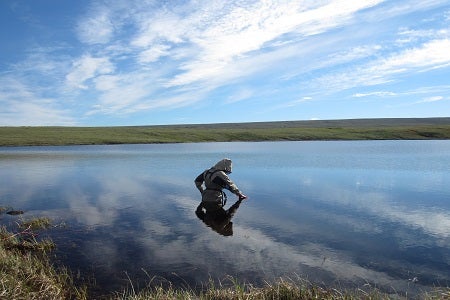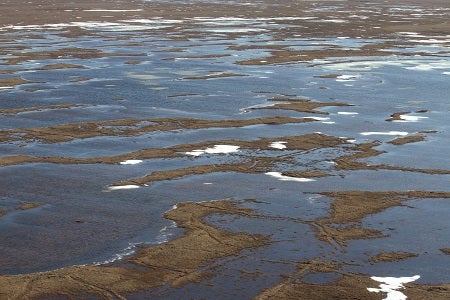
The role of DOM in freshwater C cycling is especially strong in northern latitudes for two reasons. First, permafrost soils in northern latitudes currently store more than twice the amount of C found in the atmosphere. The ongoing thawing of permafrost is the only environmental change that allows tremendous stores of organic C to be converted into CO2 on relatively short time scales, thus providing a positive and accelerating feedback to global warming. Second, in the Arctic the C fluxes from freshwaters may account for up to 40% of the net land surface C exchange with the atmosphere. Although the processing and fate of DOM is a critical aspect of C cycling, the controls on oxidation of DOM in freshwaters are poorly understood.
My PhD thesis research on DOM degradation in arctic freshwaters showed that as the residence time of DOM in sunlit surface waters increased, the chemical composition of DOM looked more and more like C that had been altered by sunlight (Cory et al. 2007). These findings suggested that photochemical processes were playing a major role in DOM degradation, which challenged the assumption that degradation of DOM was primarily due to bacteria in freshwaters.

The general view was that direct conversion of DOM to CO2 by sunlight accounted for about 10% of bacterial respiration in freshwaters, but no study had quantified concurrently all the dominant biological and photo-degradation pathways of DOM. My team and I quantified each of these pathways for DOM degradation in small streams, rivers, and lakes on the North Slope of Alaska, and found that rates of photo-mineralization to CO2 and partial photo-oxidation of DOM were 3 to 19-fold greater than rates of dark respiration by bacteria in the water column of arctic streams and lakes.
We found that photochemical processing of DOM is about one third of the total CO2 released from surface waters, and is thus an important, newly measured component of the Arctic C budget (Cory et al. 2014). In addition to this complete oxidation to CO2, much of the DOM is partially oxidized by light, and overall, photochemical processes account for 70-95% of the total DOM processed (i.e., degraded to altered forms) in the water column of arctic lakes and rivers.
My work to advance our understanding of photochemistry in C cycling is especially relevant to the vulnerability of arctic and boreal ecosystems in the face of climate change. Several key controls on the amount of DOM oxidized completely to CO2 and released to the atmosphere, versus partially oxidized and exported to oceans, will change with climate warming. These changes include the hydrologic cycle, the amount and characteristics of DOM draining permafrost soils, and the amount and timing of UV light available to surface waters. My research connecting DOM composition with rates of DOM degradation by microbes and light will continue to provide the process-level information required to understand why CO2 gas exchange with the atmosphere is changing, or why more or less DOM will be exported to oceans in the future as the Arctic changes.
For example, now we’re looking at how the balance of DOM fate may change in the Arctic, as thawing permafrost soils are releasing DOM with little prior light exposure and greater potential for photo-mineralization to CO2 (Cory et al. 2013) and (Ward & Cory 2016). Understanding the controls on DOM fate, and incorporating photochemistry into models, is critical for predictions of how the arctic C cycle will respond to and amplify climate change.
I work with biogeochemists and hydrologists to show how DOM amount and lability interact with incident UV light and hydrologic water residence time to determine whether photo-degradation is “light-limited” or “substrate-limited”, i.e., limited by the DOM substrate available (i.e., (Cory et al. 2015). Our conceptual model on DOM photo-degradation should apply to freshwaters everywhere (not just in the Arctic).
This research is in collaboration with George Kling, a limnologist and biogeochemist and Byron Crump, a microbial ecologist and is supported by the National Science Foundation.
